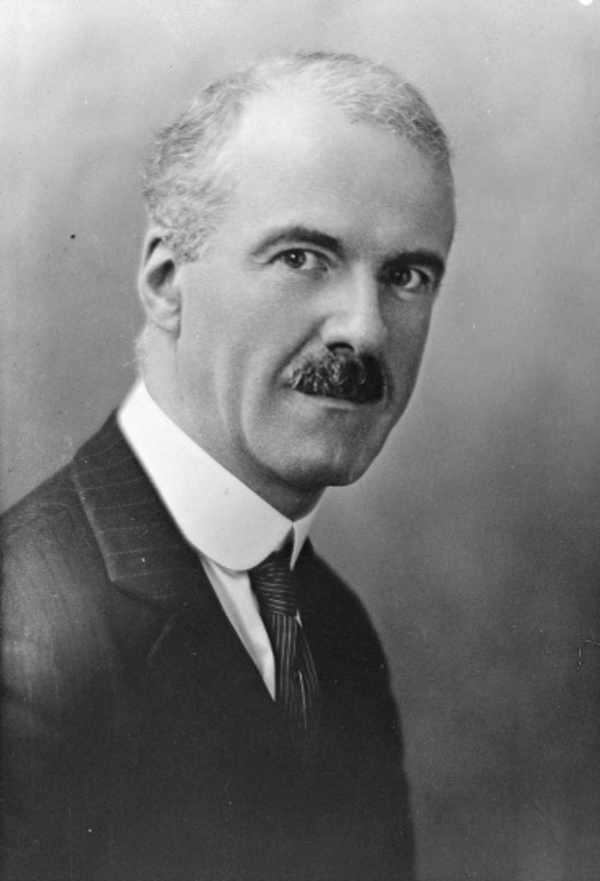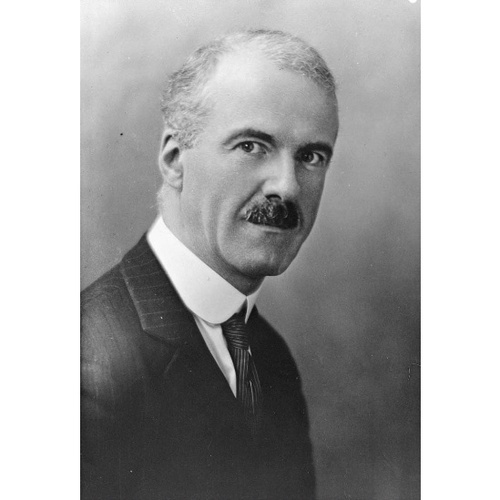
Source: Link
CAUCHON, NOULAN (baptized Joseph-Eusèbe-Noulan), surveyor, engineer, civil servant, and town planner; b. 4 March 1872 in Quebec City, son of Joseph Cauchon*, speaker of the Senate, and Maria-Louisa Noulan; m. 17 June 1920 Marguerite-Louise Le Moine in Ottawa; they had no children; d. there 28 Oct. 1935 and was buried three days later in the Le Moine-des-Pins family vault in Château-Richer, Que.
After a few months in the employ of the Quebec and Lake Saint John Railway, Noulan Cauchon worked from the age of 16 as a surveyor for the Canadian Pacific Railway (CPR). Together with the team led by Donald Alexander Stewart*, the chief engineer in its western division, he took part in exploring the Rockies and the Selkirk Mountains, thereby acquiring practical and organizational skills.
Cauchon was soon drawn to engineering, the basics of which he learned on the job as assistant to engineer Hugh David Lumsden and, from 1900, with the chief engineer William Francis Tye, who put him in charge of supervising the construction of a railway line from Port Arthur (Thunder Bay), Ont., at the head of the Great Lakes, to the Rockies. After a successful 20-year career with the CPR, Cauchon was appointed deputy engineer of the Board of Railway Commissioners for Canada in 1908. From then on, he built an extensive network of contacts in the Canadian capital, where he settled permanently.
Cauchon had a strong interest in the developing specialty of town planning. Around 1909 he educated himself in this field by reading extensively. He left the public service and in 1910 opened an engineering office in Ottawa with his associate Richard Lafontaine Haycock. Over the course of a quarter century his firm obtained numerous contracts, mapping out, among other projects, land-use plans in Quebec (Montreal and Chicoutimi [Saguenay]) and Ontario (Hamilton, London, and St Catharines), and producing reports on infrastructure development throughout Canada. In October 1911 he addressed the local branch of the Canadian Society of Civil Engineers, promoting town planning and urging those present to mobilize around this new specialty. That year, while employed by the city of Ottawa when it was considering a revamping of its water-distribution system in the aftermath of a typhoid fever epidemic, Cauchon examined the shortcomings of its town plan. The following winter he unveiled a scheme based on principles of public health and aesthetics, featuring diagonal thoroughfares to ensure better connections between the central areas and public buildings. He made no secret of his ambition to turn Ottawa into the “Washington of the North.”
Influenced by the reform movement, then in vogue in large North American cities, Cauchon, along with a few leading figures in town planning, among them the renowned Thomas Adams, established the Canadian League for Civic Improvement in 1915. A founding member of the Town Planning Institute of Canada, created in 1919, Cauchon soon became an ardent defender of the new profession, which he sought to protect from charlatans by instituting corporate practices, such as admission requirements and ethical standards, and conducting a wide-ranging educational campaign to publicize the social and economic impact of town planning. Cauchon was familiar with the teachings of the City Practical movement, which strengthened his convictions, and he set out to develop a science of spatial planning. In his writings he was already beginning to lay out the principles of a natural order: an ethical framework for preserving life, applied sociology that benefited from economic rationalization, and art forms that reflected an inherent truth. By the beginning of the 1920s, his focus had shifted from beautification to town-planning theory, which he demonstrated in, for example, designs for revamping the city of Hamilton’s railway terminal and its access.
As first president of the Ottawa Town Planning Commission in 1921, a position he would occupy until his death, Cauchon created a series of projects in the city primarily aimed at improving the principal thoroughfares. Working with the architect John Macrae Kitchen, he pursued his crusade for the adoption of a zoning plan that would be recognized as a model for Canada. Despite resistance from local authorities, he pressed for the creation of a federal district. Concurrently, he was an adviser to numerous other Canadian towns and cities and served as a technical expert for several federal parliamentary committees. He became president of the Town Planning Institute of Canada (1924–26). At the same time, he completed the design of what was to gain him recognition in Canada and internationally: hexagonal planning. In April 1925 the International City and Regional Planning Conference in New York City provided him with a crucial platform for the presentation of his seminal contribution. Inspired by geometry, he created a uniform urban grid subdivided into lots that resembled cells in a honeycomb, to help promote public health and the smooth flow of traffic. His research culminated in 1927 in Hexagonopolis – an imaginary city combining realism and aspirations for social justice, which had a great impact on his mainstream colleagues and seemed to win their acceptance. Cauchon compiled his ideas in a series of lectures on this theme, which he delivered first in Canada and then in the United States and several European countries. The French theoretician Georges Benoît-Lévy and the English architect Richard Barry Parker made their readers aware of the great advantages of this serviceable geometry. In England, Parker provided Manchester with a hexagonal district in 1932; he intended to apply Cauchon’s designs to Letchworth, but the plan never materialized.
The honorary appointments received by Noulan Cauchon towards the end of his career, including that of Canadian correspondent on the general committee of the Town and Country Planning School of Welwyn Garden City, England, contrasted with his difficulties in implementing his ideas locally. Evoking the common good, he conducted a lobbying campaign for increased public action. His proposals on town planning and public housing met with obstacles, and he ultimately found few tangible opportunities in Canada, where the market remained limited and support was weak, especially following the Great Depression. Cauchon succumbed to lobar pneumonia at the Ottawa Civic Hospital in 1935, a few months after appearing as a witness before the House of Commons special committee on housing, where his passionate appeal for planning solutions drew attention. Cauchon’s active career placed him alongside the pioneers of town planning and, in the opinion of several contemporaries, established him as the only Canadian expert of his time to enjoy a reputation abroad. Frequently hailed for the original, humanist nature of his proposed solutions, Cauchon was, in the eyes of his colleague and friend Percy Erskine Nobbs*, the incarnation of an honest town planner who knew how to reconcile social justice and economic realities.
Noulan Cauchon is the author of numerous articles, including “A theory of arterial highways and the tide of traffic,” City Planning (Boston), 1 (1925): 94–96; “Town and regional planning: address to the Technological Club of Syracuse, N.Y.,” Town Planning Instit. of Can., Journal (Ottawa), 4 (1925), no.6: 14–17; “Town planning,” Royal Architectural Instit. of Can., Journal (Toronto), 3 (1926): 165–71; “Planning organic cities to obviate congestion: orbiting traffic by hexagonal planning and intercepters,” American Academy of Political and Social Science, Annals (Philadelphia), 133 (September 1927): 241–46; and “Principles underlying town planning and zoning legislation,” La Rev. municipale (Montréal), décembre 1927: 23–25. The Noulan Cauchon fonds at LAC (R5958-0-1) includes his correspondence, lectures, journal articles, photographs, and architectural drawings.
AO, RG 80-5-536, no.16049; RG 80-8-708, no.11552. BANQ-Q, CE301-S1, 4 mars 1872; CE301-S6, 31 oct. 1935. LAC, R1181-0-2; R1181-10-5. Le Devoir, 28, 29, 31 oct. 1935. Ottawa Evening Journal, 26 Oct. 1911. Eran Ben-Joseph and D. [L. A.] Gordon, “Hexagonal planning in theory and practice,” Journal of Urban Design (Abingdon, England), 5 (2000): 237–65. D. L. A. Gordon, “‘Agitating people’s brains’: Noulan Cauchon and the City Scientific in Canada’s capital,” Planning Perspectives (London), 23 (2008): 349–79. Ken Hillis, “A history of commissions: threads of an Ottawa planning history,” Urban Hist. Rev. (Toronto), 21 (1992–93), no.1: 46–60. P. E. Nobbs, “Noulan Cauchon: an appreciation,” Royal Architectural Instit. of Can., Journal, 13 (1936): 122. Gabriel Rioux, “Le milieu de l’urbanisme à Montréal (1897–1941): histoire d’une ‘refondation’” (thèse de phd, Univ. du Québec à Montréal et Univ. Paris 1 Panthéon-Sorbonne, 2013).
Cite This Article
Gabriel Rioux, “CAUCHON, NOULAN (baptized Joseph-Eusèbe-Noulan),” in Dictionary of Canadian Biography, vol. 16, University of Toronto/Université Laval, 2003–, accessed December 31, 2025, https://www.biographi.ca/en/bio/cauchon_noulan_16E.html.
The citation above shows the format for footnotes and endnotes according to the Chicago manual of style (16th edition). Information to be used in other citation formats:
| Permalink: | https://www.biographi.ca/en/bio/cauchon_noulan_16E.html |
| Author of Article: | Gabriel Rioux |
| Title of Article: | CAUCHON, NOULAN (baptized Joseph-Eusèbe-Noulan) |
| Publication Name: | Dictionary of Canadian Biography, vol. 16 |
| Publisher: | University of Toronto/Université Laval |
| Year of publication: | 2022 |
| Year of revision: | 2022 |
| Access Date: | December 31, 2025 |



